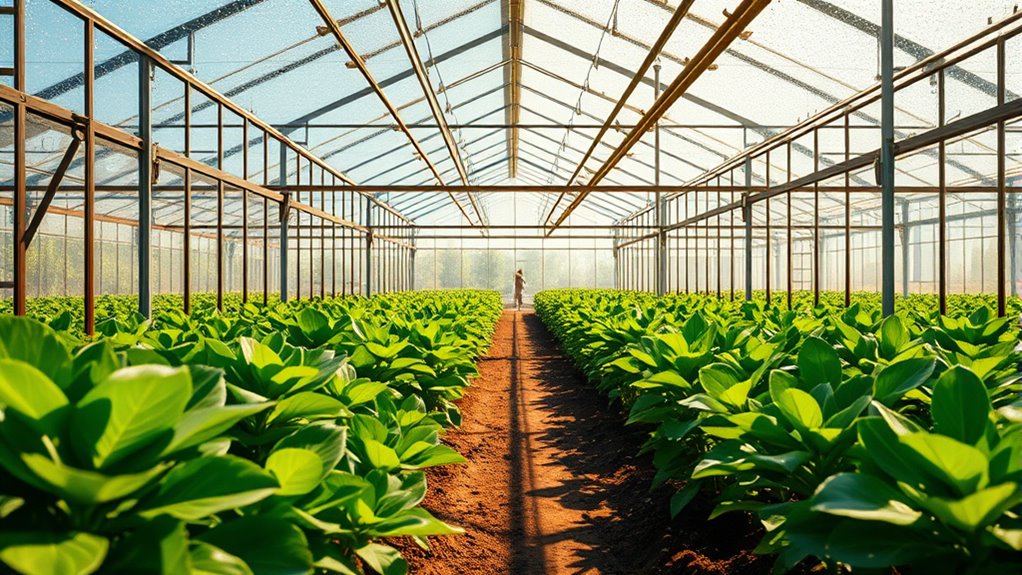The greenhouse effect is a natural process where certain gases trap heat in Earth’s atmosphere, keeping the planet warm enough to support life. However, human activities like burning fossil fuels release extra greenhouse gases such as carbon dioxide and methane, intensifying this effect. This leads to global warming, melting ice, and more extreme weather events. Understanding how this process works shows why actions to reduce emissions are essential—if you want to learn more, keep exploring these crucial concepts.
Key Takeaways
- The greenhouse effect traps heat in Earth’s atmosphere, maintaining a habitable climate by allowing sunlight in and preventing excessive heat loss.
- Human activities like burning fossil fuels increase greenhouse gases, especially carbon dioxide, intensifying the natural greenhouse effect.
- Excess greenhouse gases thicken the atmospheric “blanket,” leading to more heat retention and global warming.
- Consequences include rising temperatures, melting ice caps, sea level rise, and more extreme weather events.
- Reducing emissions through energy conservation and renewable energy is vital to mitigating global warming.

Have you ever wondered how our planet stays warm enough to support life? The answer lies in the greenhouse effect, a natural process that traps heat in Earth’s atmosphere. Without it, our world would be a frozen planet, incapable of sustaining the diverse ecosystems we see today. But in recent times, human activities have amplified this effect, leading to concerns about global warming and climate change. The main culprits are greenhouse gases like carbon dioxide, methane, and nitrous oxide. Among these, carbon dioxide plays a significant role because of its abundance and long-lasting presence in the atmosphere. When you burn fossil fuels for energy, transportation, or industry, you release large amounts of carbon dioxide into the air. This increase intensifies the greenhouse effect, trapping more heat than usual and raising global temperatures. The more carbon dioxide you emit, the more the planet warms — and that’s where the problem of global warming begins to take shape. It’s not just about feeling hotter during summer; global warming causes widespread changes in weather patterns, melting ice caps, rising sea levels, and more frequent extreme weather events. The greenhouse effect works because certain gases in the atmosphere act like a blanket, allowing sunlight to enter but trapping the heat that radiates back from Earth’s surface. When the balance of these gases shifts due to excess carbon dioxide, the blanket becomes thicker, and more heat gets trapped. This process is natural, but human activities have upset the balance, boosting the greenhouse effect beyond its normal levels. The consequences are serious, and they’re happening faster than many expected. As global warming accelerates, you might notice more intense storms, droughts, and unpredictable seasons. The rising sea levels threaten coastal communities and ecosystems, while the warming climate endangers wildlife and agriculture worldwide. Understanding the science behind the greenhouse effect is key to recognizing why reducing carbon dioxide emissions is critical. It’s not only about protecting the environment but also about safeguarding future generations from the worst impacts of climate change. So, every action you take—whether conserving energy, supporting renewable resources, or advocating for policy changes—can help reduce the excess carbon dioxide in the atmosphere. By doing your part, you help slow down global warming and preserve the delicate balance that keeps our planet habitable. The science behind the greenhouse effect shows that human choices directly influence Earth’s climate, making awareness and action more important than ever.
Frequently Asked Questions
How Do Natural Greenhouse Gases Differ From Human-Made Ones?
Natural greenhouse gases differ from human-made ones mainly in their sources and impact. You should know that natural variability influences these gases through processes like volcanic eruptions or animal respiration, which are part of natural greenhouse gas sources. Human activities, however, add extra greenhouse gases to the atmosphere, increasing overall concentrations. This excess intensifies the greenhouse effect, leading to global warming, as human-made gases tend to linger longer and trap more heat.
What Role Do Oceans Play in Greenhouse Gas Absorption?
You might not realize it, but oceans play a crucial role in greenhouse gas absorption through oceanic absorption and marine carbon sequestration. As you observe the sea, remember it acts as a giant sink, taking in carbon dioxide from the atmosphere. This process helps regulate climate, but increased emissions can overwhelm it, reducing its effectiveness. Protecting oceans supports this natural carbon storage, vital for combating climate change.
Can the Greenhouse Effect Be Reversed Naturally?
You wonder if the greenhouse effect can reverse naturally. While some processes like forest regeneration help absorb CO₂, they can’t fully reverse it alone. Geoengineering solutions, such as reforestation and ocean fertilization, can assist, but they’re not entirely natural. Ultimately, reducing emissions is essential, as natural methods alone won’t undo the damage. Your best bet is supporting sustainable practices to limit further warming.
How Do Different Ecosystems Respond to Increased Greenhouse Gases?
You see, ecosystems respond differently to increased greenhouse gases based on their resilience and biodiversity impacts. Some, like forests, may adapt or recover quickly, while others, such as coral reefs, struggle due to sensitive species loss and reduced resilience. You might notice shifts in species composition and ecosystem functions, which can lead to decreased biodiversity impacts overall. Your actions can influence these responses by reducing greenhouse gas emissions and supporting conservation efforts.
What Are the Most Effective Ways to Reduce Greenhouse Gases Globally?
Think of Earth’s atmosphere as a delicate balance scale—you can tip it toward sustainability by embracing renewable energy and enhancing carbon sequestration. You can reduce greenhouse gases globally by shifting to solar, wind, and other clean sources, cutting reliance on fossil fuels. Additionally, supporting practices like reforestation helps absorb excess CO2. Together, these actions strengthen the planet’s natural defenses and restore harmony in our shared environment.
Conclusion
Now that you understand the greenhouse effect, picture Earth as a cozy blanket wrapped around a campfire, trapping warmth and shimmering with life. If that blanket thickens too much, the fire roars uncontrollably, melting ice and stirring storms. You hold the power to loosen that blanket—reducing emissions and letting the planet breathe. Together, you can turn down the heat, ensuring our world remains a vibrant, safe haven for generations to come.









